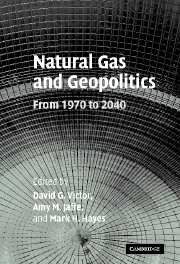Book contents
- Frontmatter
- Contents
- List of figures
- List of tables
- List of boxes
- List of contributors
- Foreword by James A. Baker, III
- Acknowledgments
- List of acronyms and abbreviations
- Part I Introduction and context
- Part II Historical case studies
- 2 Introduction to the historical case studies: research questions, methods and case selection
- 3 The Transmed and Maghreb projects: gas to Europe from North Africa
- 4 Liquefied natural gas from Indonesia: the Arun project
- 5 Bypassing Ukraine: exporting Russian gas to Poland and Germany
- 6 Natural gas pipelines in the Southern Cone
- 7 International gas trade in Central Asia: Turkmenistan, Iran, Russia, and Afghanistan
- 8 Liquefied natural gas from Qatar: the Qatargas project
- 9 Liquefied natural gas from Trinidad & Tobago: the Atlantic LNG project
- 10 Politics, markets, and the shift to gas: insights from the seven historical case studies
- Part III International gas trade economics
- Part IV Implications
- Appendix: Technical notes
- Index
- References
8 - Liquefied natural gas from Qatar: the Qatargas project
Published online by Cambridge University Press: 22 September 2009
- Frontmatter
- Contents
- List of figures
- List of tables
- List of boxes
- List of contributors
- Foreword by James A. Baker, III
- Acknowledgments
- List of acronyms and abbreviations
- Part I Introduction and context
- Part II Historical case studies
- 2 Introduction to the historical case studies: research questions, methods and case selection
- 3 The Transmed and Maghreb projects: gas to Europe from North Africa
- 4 Liquefied natural gas from Indonesia: the Arun project
- 5 Bypassing Ukraine: exporting Russian gas to Poland and Germany
- 6 Natural gas pipelines in the Southern Cone
- 7 International gas trade in Central Asia: Turkmenistan, Iran, Russia, and Afghanistan
- 8 Liquefied natural gas from Qatar: the Qatargas project
- 9 Liquefied natural gas from Trinidad & Tobago: the Atlantic LNG project
- 10 Politics, markets, and the shift to gas: insights from the seven historical case studies
- Part III International gas trade economics
- Part IV Implications
- Appendix: Technical notes
- Index
- References
Summary
Introduction
The Qatargas LNG project is suggestive of the many political, economic, and technical challenges inherent to first-in-country LNG export projects. In this chapter we examine the myriad factors that stalled the export of Qatar's massive gas resources for over twenty-five years from their first discovery in 1971 – as well as the alignment of political and economic interests that ultimately moved the project forward in the early 1990s. The Qatargas case is also a study of a “last-of-a-kind” LNG project. This case and the earlier Arun study (chapter 4 in this volume) bookend the period of Asia Pacific LNG projects characterized by the sole dominance of Japanese gas buyers with robust Japanese government support.
The North West Dome (now North Field) gas structure was discovered off the coast of Qatar by Shell in 1971, in the course of the company's prospecting for oil (see the maps in figures 8.1 and 8.2). An oil field would have been a much-preferred find at the time; gas was not a priority for the newly independent country awash in oil revenues. Oil exports were garnering the tiny country of 130,000 people $2 billion per year in 1975, growing to over $5 billion per year in 1980.
Only when the oil revenues started to wane in the early 1980s did gas exports slowly rise in importance to the Emir. Still, progress proceeded slowly. The Emir sought analysis and input from foreign advisers. Early plans prioritized domestic gas development over gas export projects.
- Type
- Chapter
- Information
- Natural Gas and GeopoliticsFrom 1970 to 2040, pp. 234 - 267Publisher: Cambridge University PressPrint publication year: 2006
References
- 1
- Cited by

